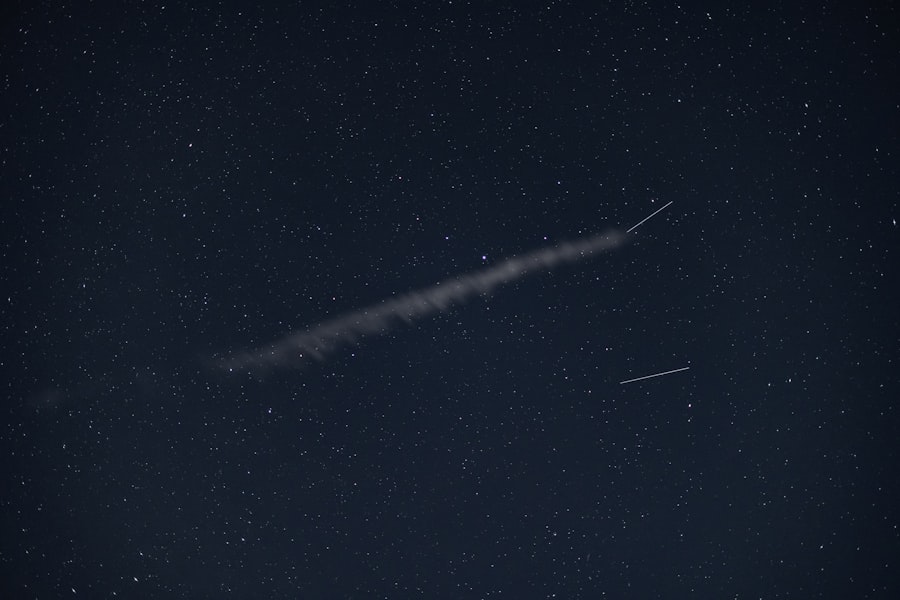The Drake Passage, a body of water located between the southern tip of South America and Antarctica, is known for its tumultuous seas and rich marine biodiversity. However, it recently gained notoriety for an extraordinary celestial event: the Drake Passage Meteor. This meteor, which streaked across the sky with a brilliant display of light, captured the attention of astronomers and the general public alike.
Its appearance not only sparked scientific curiosity but also ignited discussions about the implications of such events on Earth and beyond. The meteor’s journey through the atmosphere and its subsequent impact on Earth has become a focal point for researchers and enthusiasts, leading to a deeper understanding of meteoric phenomena.
As it traversed the skies, it provided a unique opportunity for scientists to study the characteristics of meteors and their potential effects on our planet. The event has prompted a wave of interest in both amateur and professional astronomy, as people seek to comprehend the significance of such occurrences. The meteor’s legacy is not merely one of spectacle; it has opened new avenues for research and exploration in the field of astronomy.
Key Takeaways
- The Drake Passage Meteor is a significant celestial event that has captured the attention of astronomers and the public alike.
- The discovery of the Drake Passage Meteor has provided valuable insights into the composition and origins of celestial bodies.
- Characteristics of the Drake Passage Meteor, such as its size and trajectory, have contributed to a better understanding of meteor phenomena.
- The impact of the Drake Passage Meteor on Earth has sparked interest in its potential implications for future research and its connection to other celestial events.
- The Drake Passage Meteor has left a lasting legacy in astronomy, shaping our understanding of the universe and inspiring further observations and studies.
The Discovery of the Drake Passage Meteor
The discovery of the Drake Passage Meteor was serendipitous, occurring during a routine observation by a group of astronomers stationed in the region. On a clear night, as they scanned the skies for celestial bodies, they were taken aback by a sudden flash of light that illuminated the darkness. Initial reports indicated that the meteor was unusually bright and left a long-lasting trail, prompting immediate investigations into its origin and trajectory.
The event was quickly documented, and images captured by both professional telescopes and amateur cameras flooded social media platforms, further amplifying interest in this astronomical phenomenon. As news of the meteor spread, scientists from various institutions collaborated to analyze its path and composition. They utilized data from satellite observations and ground-based telescopes to trace its trajectory back to its source in the asteroid belt.
This collaborative effort underscored the importance of teamwork in scientific discovery, as researchers pooled their resources and expertise to unravel the mysteries surrounding the Drake Passage Meteor. The excitement surrounding its discovery not only highlighted advancements in observational technology but also showcased the global community’s commitment to understanding our universe.
Characteristics of the Drake Passage Meteor

The Drake Passage Meteor exhibited several remarkable characteristics that distinguished it from typical meteoric events. First and foremost was its size; measuring approximately 10 meters in diameter, it was significantly larger than most meteors that enter Earth’s atmosphere. This size contributed to its brilliant display as it descended, creating a dazzling light show that could be seen from hundreds of miles away.
The meteor’s composition was also noteworthy; initial analyses suggested it contained a unique blend of metals and minerals, including nickel and iron, which are often found in larger celestial bodies. Another striking feature of the Drake Passage Meteor was its speed. Traveling at an astonishing velocity of over 30 kilometers per second, it generated immense heat upon entering the atmosphere, resulting in a spectacular fireball effect.
This rapid descent created shockwaves that were felt by residents in nearby coastal towns, further emphasizing the meteor’s extraordinary nature. Scientists were particularly interested in studying these characteristics, as they provided valuable insights into the formation and evolution of meteors, as well as their potential impact on Earth.
The Impact of the Drake Passage Meteor on Earth
| Metrics | Data |
|---|---|
| Meteor Name | Drake Passage Meteor |
| Impact Date | Estimated to be 2.6 million years ago |
| Impact Location | Drake Passage, Southern Ocean |
| Impact Size | Estimated to be 1.2 kilometers in diameter |
| Environmental Impact | Caused significant climate change and mass extinction |
| Scientific Significance | Provides insights into the effects of large impacts on Earth’s history |
The impact of the Drake Passage Meteor on Earth was multifaceted, encompassing both physical and scientific dimensions. Upon entering the atmosphere, the meteor disintegrated at an altitude of approximately 20 kilometers, creating a series of small fragments that scattered across a wide area. While no significant damage was reported, the event served as a reminder of the potential hazards posed by larger meteors.
Scientists emphasized that even small fragments could have devastating effects if they were to strike populated areas or critical infrastructure. In addition to its physical impact, the meteor also had significant implications for scientific research. The event prompted a surge in studies focused on meteoric impacts and their consequences for Earth’s environment.
Researchers began to explore how such events could influence climate patterns, geological formations, and even biological evolution over time. The Drake Passage Meteor thus became a catalyst for renewed interest in planetary defense strategies, as scientists sought to better understand how to mitigate potential threats from future meteoric events.
The Significance of the Drake Passage Meteor in Astronomy
The significance of the Drake Passage Meteor extends beyond its immediate impact; it represents a pivotal moment in contemporary astronomy. As one of the most observed meteors in recent history, it provided an unprecedented opportunity for researchers to gather data on meteoric behavior and characteristics. The wealth of information collected during this event has contributed to ongoing discussions about planetary science and cosmic phenomena.
Moreover, this meteor has reignited interest in studying near-Earth objects (NEOs) and their trajectories. The data gathered from the Drake Passage Meteor has implications for understanding other celestial bodies that may pose risks to Earth.
In this way, the Drake Passage Meteor has become an essential case study for both current research and future explorations in astronomy.
The Observations and Studies of the Drake Passage Meteor

Following its discovery, a multitude of observations and studies were conducted to analyze various aspects of the Drake Passage Meteor. Researchers utilized advanced imaging techniques to capture high-resolution images of its trajectory, while spectroscopic analyses were employed to determine its chemical composition. These studies revealed not only the meteor’s physical properties but also provided insights into its origin within the solar system.
In addition to laboratory analyses, field studies were conducted in areas where fragments were believed to have landed. Teams of scientists scoured remote locations in search of meteorite samples that could offer further clues about its composition and history. These efforts underscored the collaborative nature of modern scientific inquiry, as researchers from different disciplines came together to share knowledge and resources in pursuit of a common goal.
The findings from these studies have enriched our understanding of meteors and their role within our solar system.
The Potential Implications of the Drake Passage Meteor for Future Research
The implications of the Drake Passage Meteor extend far beyond its immediate observations; they pave the way for future research endeavors in multiple fields. One significant area of interest is planetary defense, where scientists are increasingly focused on developing strategies to detect and mitigate potential threats from NEOs. The data collected from this meteor can inform models that predict how similar objects might behave upon entering Earth’s atmosphere.
Furthermore, this event has sparked discussions about international collaboration in space research. As countries around the world recognize the importance of monitoring celestial events, there is a growing consensus that sharing data and resources is essential for advancing our understanding of meteoric phenomena. The Drake Passage Meteor serves as a case study for how collaborative efforts can lead to significant advancements in scientific knowledge and preparedness for future events.
The Connection Between the Drake Passage Meteor and Other Celestial Events
The Drake Passage Meteor is not an isolated incident; it is part of a broader tapestry of celestial events that have captivated humanity throughout history. Its connection to other meteoric phenomena highlights patterns that can be observed across time and space. For instance, researchers have noted similarities between this meteor and previous events recorded in historical texts, suggesting that such occurrences may be more common than previously thought.
Moreover, this meteor’s trajectory intersected with known meteor showers, raising questions about potential links between different celestial events. By studying these connections, astronomers can gain insights into how various cosmic phenomena interact with one another. This interconnectedness emphasizes the complexity of our universe and underscores the importance of continued research into meteoric activity.
The Public’s Reaction to the Drake Passage Meteor
The public’s reaction to the Drake Passage Meteor was one of awe and fascination. As images and videos circulated on social media platforms, people from all walks of life expressed their wonder at witnessing such a spectacular event. News outlets reported on sightings from various locations, capturing stories from individuals who experienced the meteor firsthand.
This widespread interest highlighted humanity’s innate curiosity about celestial phenomena and our desire to connect with something greater than ourselves. In addition to excitement, there was also a sense of urgency regarding public awareness about meteoric events. Many individuals began discussing planetary defense strategies and advocating for increased funding for astronomical research.
This grassroots movement demonstrated how a single event could galvanize public interest in science and inspire conversations about our place in the universe.
The Cultural and Historical Impact of the Drake Passage Meteor
The cultural impact of the Drake Passage Meteor is likely to resonate for years to come. Throughout history, meteors have been viewed as omens or messages from the cosmos, often inspiring myths and legends across various cultures. The recent event has rekindled these age-old narratives while also prompting new interpretations in contemporary society.
Artists, writers, and filmmakers have drawn inspiration from the meteor’s dramatic appearance, incorporating it into creative works that explore themes of wonder, fear, and humanity’s relationship with nature. This cultural dialogue reflects how celestial events can shape human experience and influence artistic expression over time.
The Legacy of the Drake Passage Meteor
In conclusion, the legacy of the Drake Passage Meteor is multifaceted, encompassing scientific discovery, public engagement, cultural reflection, and future research implications. Its discovery has sparked renewed interest in astronomy while highlighting humanity’s connection to cosmic phenomena. As researchers continue to analyze data collected from this event, they will undoubtedly uncover new insights that deepen our understanding of meteors and their role within our solar system.
Ultimately, the Drake Passage Meteor serves as a reminder that we are part of a vast universe filled with mysteries waiting to be explored. Its impact will be felt not only in scientific circles but also within cultural narratives that shape our understanding of existence itself. As we look to the stars with curiosity and wonder, events like this meteor will continue to inspire generations to come.
The Drake Passage is a significant body of water that connects the Atlantic and Pacific Oceans, and it is often associated with challenging weather conditions and unique meteorological phenomena. For those interested in exploring more about the meteorological aspects of the Drake Passage, a related article can be found on MyGeoQuest. This article delves into the unique weather patterns and the impact of the passage on global ocean currents. To read more about this fascinating topic, visit the article on MyGeoQuest.
WATCH NOW! Drake Passage: Earth’s Deadliest Waters Revealed
FAQs
What is the Drake Passage?
The Drake Passage is the body of water between the southern tip of South America and the northern tip of the Antarctic Peninsula. It is known for its rough seas and strong winds, making it one of the most challenging maritime routes in the world.
What is a meteor?
A meteor is a small rocky or metallic body that enters the Earth’s atmosphere and produces a streak of light as it burns up due to friction with the air. Meteors are commonly known as shooting stars.
What is the Drake Passage meteor?
The Drake Passage meteor refers to a meteor that was observed or discovered in the vicinity of the Drake Passage. It could have entered the Earth’s atmosphere and burned up over the passage, or it could have been observed from a research vessel or station in the area.
Why is the Drake Passage meteor significant?
Meteors are of scientific interest as they provide valuable information about the composition and origins of celestial bodies. A meteor observed in the Drake Passage could also be of interest to researchers studying the region’s unique weather patterns and atmospheric conditions.
How are meteors studied?
Meteors are studied using a variety of methods, including visual observation, radar detection, and analysis of meteorite fragments that reach the Earth’s surface. Researchers also use specialized instruments and telescopes to track and study meteors as they enter the atmosphere.
